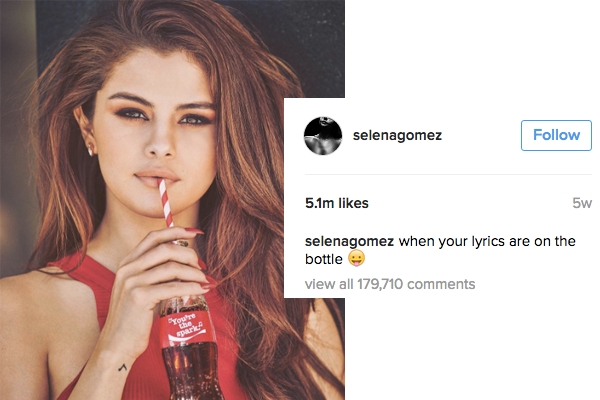Coca-Cola recently hit a marketing home run when pop artist Selena Gomez posted a picture of herself on Instagram holding the company’s iconic glass bottle. The photo became the most-liked of all time on the social media site, earning a whopping 5.1 million likes (as of Aug. 1).
The sponsored photo was likely part of the company’s “Share a Coke and a Song” campaign, which features popular song lyrics splashed across its cans and bottles. It’s unknown how much the soda conglomerate paid for the photo, but media analysts do have a hunch as to how much Gomez’s posts are worth: $550,000, when shared across Twitter, Instagram and Facebook, according to D’Marie Analytics.
That’s a big chunk of change, but it’s hard to know if Coca-Cola saw any ROI without knowing how much the company paid Gomez to participate in the campaign. Coca-Cola likely has a pretty good idea if the post paid off, but many marketers who leverage influencers don’t — one reason why these types of campaigns remain a murky and often irritating strategy for B2C marketers.
Interestingly enough, this is where B2B marketers may have an advantage: The concept of “pay-to-play” social media posts just won’t fly in the B2B arena.
“Most B2B influencers and their audiences cannot be bought in the B2C sense, for a few reasons,” said Jim Williams, VP of Marketing at advocate marketing platform Influitive. “First, influencers are fewer and farther between in B2B, and audiences have less attention to give. Both the influencers and their audiences are more discerning about which brands they work with, what they say about them, and why.”
He continued, “Next, most B2B companies don’t have products that you can just ‘feature’ or ‘try’ for a short period of time. It’s not lipstick or protein powder or clothing. And lastly, the majority of B2B influencers are not full-time influencers. They often have a side gig, a full-time role at another company, their own business, or freelance work from which they derive much of their influence.”
So does that mean B2B marketers should just forget about influencer campaigns? Not at all, Williams said.
“Every industry has its influencers, whether it’s analysts, social media personalities, columnists or other experts, and every person is influenced by their peers,” he pointed out.
Williams is correct: In Demand Gen Report’s 2016 B2B Buyer’s Survey Report, respondents pointed to their “peers/colleagues” as the third most important resource that informed them about their purchase, behind web search and vendor websites. Almost half of respondents (49%) listed their peers and colleagues as a top source of information, rising significantly from 20% in 2015.
Just like how the purchase process is much longer and more complex in the B2B arena, finding and leveraging influencers is much more involved— but the payoff is potentially much larger, too.
“B2B influencers need to be nurtured and engaged over a long period of time,” Williams said. “It’s not ‘one and done.’ You may not need to pay them anything at all, but it will take a significant investment of time, energy and perhaps your own influence to get their attention and promote your brand.”
Once that happens, however, that peer validation can lead directly to revenue through referrals, references and cross-sell/upsell opportunities, he added. One tactic that B2B companies can employ is offering their solution at a lower cost or free of charge to an industry influencer with a genuine need for it, in exchange for referrals to their client base.
Another strategy that Williams recommended is advocacy marketing — cultivating loyal brand advocates from your current crop of customers.
“There is evidence that peers and customer advocates shape buyer decisions more than influencers, sales reps or company websites,” Williams noted, pointing to a blog post by Gartner analyst Hank Barnes. “Across all areas of the marketing and sales funnels, advocates can offer value: they can offer referrals of new business, provide references to prospects in the sales process, and positively review your brand online, or talk about you in social media.”
The two strategies, however, are not exclusive. B2B marketers can cultivate chatter by leveraging one strong influencer (akin to Gomez) or many smaller voices that together make a powerful statement.
And while there may be no single person in the B2B arena who carries the social media clout of Selena Gomez, there are certainly rock stars within each industry. My suggestion: Find yours, and offer them a Coke.







